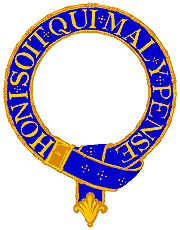
RBH Home
Maps & Travels
Articles
Legends
Towns & Villages
Castles & Houses
Churches
Biographies
Gentry
Family History
Odds & Ends
Mail David
The Order of the Garter
Honi Soit qui Mal y Pense
 It
was the warrior-classes of the 11th and 12th centuries who first developed
the medieval notion of knighthood and chivalry. The Crusades in the Middle
East had released these men from the constraints of feudalism, and they
expressed their new-found identity by the creation of military and
religious orders of chivalry. The earliest orders were fraternities of
like-minded men, drawn from a particular social class and bound together
in a common purpose. Although still modelled on humanitarian and
egalitarian principles, the later orders were fundamentally elitist. Loyal
service to the monarch could bring the supreme reward of membership to
such organisations and pre-eminent amongst them was, and still is, the
Most Noble Order of the Garter.
It
was the warrior-classes of the 11th and 12th centuries who first developed
the medieval notion of knighthood and chivalry. The Crusades in the Middle
East had released these men from the constraints of feudalism, and they
expressed their new-found identity by the creation of military and
religious orders of chivalry. The earliest orders were fraternities of
like-minded men, drawn from a particular social class and bound together
in a common purpose. Although still modelled on humanitarian and
egalitarian principles, the later orders were fundamentally elitist. Loyal
service to the monarch could bring the supreme reward of membership to
such organisations and pre-eminent amongst them was, and still is, the
Most Noble Order of the Garter.
Of the origin of the Most Noble Order we know little. According to its
historian, Elias Ashmole, it commemorated an occasion when King Edward
III of England had "given forth his own garter as the signal
for a battle," which Ashmole takes to be Crécy. A better-known
theory associated the foundation of the Garter with a trivial
mishap at a Court function, when the Fair Maid of Kent dropped a
garter which the King, to cover her embarrassment, picked up and bound on
his own leg, remarking, "Honi Soit qui Mal y Pense" -
"Shame to him who thinks ill of it." This fable appears to have
originated in France and was, perhaps, invented to bring discredit on the
Order. There is a natural unwillingness to believe that the World's
foremost Order of Chivalry had so frivolous a beginning, and we may more
readily accept Froissart's account, who tells us:
"The King of England took pleasure to new re-edify the Castle of
Windsor, the which was begun by King
Arthur, and there first began the Table
Round, whereby sprang the fame of so many noble knights throughout
all the World. Then King Edward determined to make an Order and a
Brotherhood ….. to be called Knights of the Blue Garter, and a feast to
be kept yearly on St. George's Day."
So the Order may have been intended as a revival of the mythical Round
Table. King Edward and his court certainly revelled in the ethos of the
Arthurian tales. Pageants, including jousting tournaments, became known as
'Round Tables' and knights even met around circular tables like that still
to be seen at Winchester.
The informal creation of such an order
of knights, after the great tournament at Windsor
in 1344, appears to have led to the formal instigation of the Order a few
years later. The exact date is controversial, as records are not extant,
but St. George's Day 1348 seems likely. The members consisted of
twenty-four knights, the monarch and the Prince
of Wales. The two latter are always included; whilst women have
been eligible since early times. St. George has always been the society's patron and their home is the
Collegiate Chapel Royal of St. George in Windsor
Castle, Their heraldic stall plates, dating back to 1390, and
colourful banners are still displayed there today.
The symbolism of the garter itself still remains obscure. A record of the
Order, compiled in Henry
VIII's reign, relates that Richard
I, during his crusade, gave garters to certain knights as tokens
of honour, and it was supposed that Edward III followed this example. But
the legend appears to have no good foundation. Ashmole regarded the
circular garter as an emblem of "unity and society." It was
certainly a very suitable stylised heraldic device and, worn below the
knee, was a prominent identifier on mounted knights.
While Edward III may outwardly have professed the Order of the Garter to
be a revival of the Round Table, it is probable that privately its
formation was a move to gain support for his dubious claim to the French
throne. The motto of the Order is a denunciation of those who think ill of
some specific project, and not a mere pious invocation of evil upon
evil-thinkers in general. "Shame be to him who thinks ill of it"
was probably directed against anyone who should oppose the King's design
on the French Crown. And it is significant that the colours of the garter
- blue embroidered with gold - are those of the French Royal Arms.
Furthermore, no French knights attended the feast of inauguration. All
things considered, it seems highly likely that the Order originally
represented the assembly of chivalry to aid King Edward of England to
become King Edward of France.
